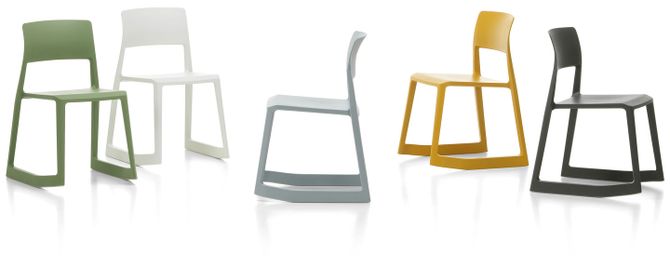
Tip Ton
Edward Barber & Jay Osgerby, 2011
Information
- Back, seat, base: dyed-through polypropylene, 100 % recyclable.
- Glides: polyethylene.
- Stacking: Tip Ton can be stacked up to 4 chairs high on the floor, up to 11 on a stacking trolley. A stacking trolley is separately available.
- Outdoor use: suitable for utilisation outdoors on a temporary or seasonal basis, following care instructions. After prolonged exposure to the elements, clean and store away in a dry, sheltered place to ensure lasting use and avoid any deterioration in appearance.
Tip Ton
Tip Ton defines a whole new chair typology: the solid plastic chair with forward-tilt action. Its name refers to the characteristic dual sitting postures – from a normal position, Tip Ton can be tipped forwards a few degrees, where the chair then stays in place. The forward-tilt position, until now the preserve of mechanical office chairs, straightens the pelvis and spine and thus improves circulation to the abdominal and back muscles. In a 2010 study, ETH Zurich – one of the world’s leading universities of applied sciences – investigated the health benefits of a forward-leaning sitting position. The results confirmed increased muscle activity in the abdominal and back areas, which boosts the supply of oxygen to all parts of the body. Tip Ton makes all of this possible for the first time ever in the form of an economical and robust plastic chair, thereby opening up many new areas of use. In addition to Tip Ton in the polypropylene version, there is now also Tip Ton RE, which is made out of recycled polypropylene. Both models are manufactured from a single mould and have no mechanical components, making them extremely durable and 100% recyclable. Tip Ton and Tip Ton RE can be stacked up to four chairs high. Tip Ton comes in a choice of different colours; Tip Ton RE is exclusively available in grey.
Edward Barber & Jay Osgerby
Edward Barber and Jay Osgerby studied architecture as fellow students at the Royal College of Art in London. Since that time, their collaborative work has probed the interface between industrial design, furniture design and architecture.